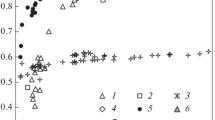Abstract
A mathematical model of mass transfer in an atmospheric bubbling deaerator storage tank at thermal power stations (TPS) to calculate the removal efficiency of dissolved gases from water is considered. For mathematical simulation and calculation of the deaerator efficiency, a system of differential equations of mass and heat transfer is written in a local form for the liquid phase of the layer with volume interphase sources of mass and heat. Mass transfer of the dissolved gases from water to the vapor phase is taken into account using volume interphase sources and the balance equations. Parameters of the interphase sources and correlations for calculating the eddy viscosity of the liquid phase depending on bubbling conditions are given. Results from the system of equations' numerical solution are presented and compared with the available experimental data on the final concentration of dissolved oxygen at the deaerator outlet. Curves of the efficiency of dissolved oxygen removal depending on the operating conditions and design characteristics of the bubbling process are presented, and scientific-and-engineering solutions have been developed to upgrade the bubbling storage tank. It has been found that an increase in gas velocity sharply raises the deaeration efficiency to a certain value (depending on the specified initial parameters), and the efficiency growth is then retarded. Similarly, increasing the length of a bubbling device improves the efficiency in removal of dissolved oxygen from water. One of the causes of a decrease in the water deaeration efficiency is likely to be back mixing of the flow. Upgrading of the deaerator tank is in the installation of perforated baffles across the flow to considerably reduce back mixing of the liquid phase. This increases the driving force of mass transfer, and its efficiency improves by five to 20% depending on the steam velocity. The presented mathematical model can be generalized to a wide range of bubbling apparatuses with a high two-phase layer.






Similar content being viewed by others
REFERENCES
E. U. Yamleeva and V. I. Sharapov, “Investigation of the aeration process of deaerated water in storage tanks of thermal power plants of Ul’yanovsk,” Vestn. Ul’yanovsk. Gos. Tekh. Univ., No. 1, 42–47 (2018).
V. I. Sharapov, E. V. Kudryavtseva, and O. V. Pazushkina, “Mass exchange and hydrodynamics of deaerators of thermal power plants during their use as a desorption medium of natural gas,” Izv. Vyssh. Uchebn. Zaved., Probl. Energ. 19 (1–2), 86–94 (2017).
V. I. Sharapov and E. V. Kudryavtseva, “Technical and economic assessment of the application of low-temperature water deaeration technologies,” Prom. Energ., No. 6, 23–26 (2017).
G. V. Ledukhovskii, Yu. E. Barochkin, V. P. Zhukov, V. N. Vinogradov, and I. A. Shatova, “Water deaeration in water-cooling systems of the stator winding in a turbogenerator with hydrogen-water cooling,” Therm. Eng. 65, 751–755 (2018). https://doi.org/10.1134/S004060151810004X
G. V. Ledukhovskii, “Modeling the water decarbonization processes in atmospheric deaerators,” Therm. Eng. 64, 127–133 (2017). https://doi.org/10.1134/S0040601517020057
G. V. Ledukhovskii, “Experimental studies and modeling of the carbonic acid removal processes from the water in atmospheric-pressure deaerators,” Vestn. Ivanov. Gos. Energ. Univ., No. 3, 5–13 (2016).
A. A. Korotkov, Improving the Efficiency of Water Decarbonization by Thermal Atmospheric-Pressure Deaerators , Candidate’s Dissertation in Engineering (Ivanovo State Power Engineering Univ, Ivanovo, 2013).
R. I. Nigmatulin, Dynamics of Multiphase Media (Nauka, Moscow, 1987; Hemisphere, New York, 1991).
V. N. Sokolov and I. V. Domanskii, Gas-Liquid Reactors (Mashinostroenie, Leningrad, 1976) [in Russian].
A. G. Laptev and M. I. Farakhov, Hydromechanical Processes in Petroleum Chemistry and Power Engineering (Kazan. Gos. Univ, Kazan, 2008) [in Russian].
A. G. Laptev, Models of the Boundary Layer and Calculation of Heat-and-Mass Transfer Processes (Kazan. Gos. Univ, Kazan, 2007) [in Russian].
A. G. Laptev, M. M. Basharov, E. A. Lapteva, and T. M. Farakhov, Models and Efficiency of the Processes of Multiphase Transfer, Ed. by A. G. Lapteva (Tsentr Innovatsionnykh Tekhnol., Kazan’, 2017) [in Russian].
A. G. Laptev, R. Sh. Misbakhov, and E. A. Lapteva, “Numerical simulation of mass transfer in the liquid phase of the bubble layer of a thermal deaerator,” Therm. Eng. 62, 911–915 (2015). https://doi.org/10.1134/S0040601515120058
Funding
The investigation was performed under a grant of the Russian Science Foundation (project no. 18-79-10136).
Author information
Authors and Affiliations
Corresponding author
Additional information
Translated by T. Krasnoshchekova
Rights and permissions
About this article
Cite this article
Laptev, A.G., Lapteva, E.A. A Mathematical Model and Design Calculation of a Thermal Deaerator with a Bubbling Storage Tank. Therm. Eng. 66, 681–686 (2019). https://doi.org/10.1134/S0040601519090027
Received:
Revised:
Accepted:
Published:
Issue Date:
DOI: https://doi.org/10.1134/S0040601519090027



